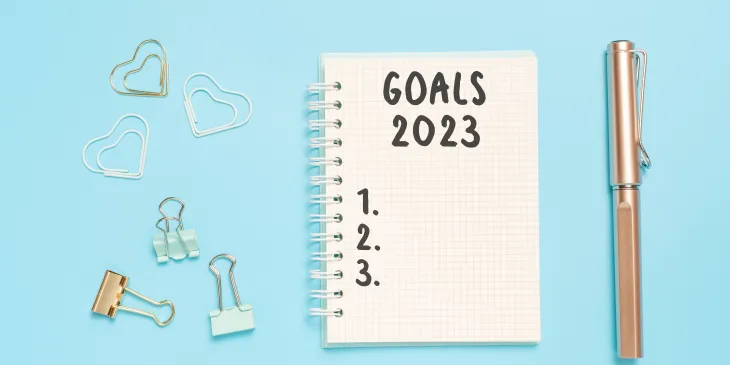5 Tips for Maximizing Your New Year’s Resolutions

Millions of Americans set annual resolutions specific to their lifestyles, such as health, fitness, nutrition, weight loss, career, finances, etc.
Unfortunately, many resolutions fizzle out before they’ve even begun. Why? The approach is a big part; it’s how you establish and attack your goals. With the right plan, you can succeed with your New Year’s resolutions, and we’re here to help.
With inflation beginning to cool, this year might be an excellent time to set your resolutions for meeting your financial goals. After all, we could all use more money in our pockets and bank accounts. To maximize your chances for success, we have some tips to get you started, and you can begin by creating smart goals.
Set S.M.A.R.T. Goals
Not all goals are smart goals, just as not all smartphone features are, well, the best features. Just ask autocorrect.
It is essential to set the right goals, especially if you intend to sustain them long-term. Therefore, you’ll need S.M.A.R.T., a mnemonic acronym for specific, measurable, achievable, relevant, and time-bound goals.
Specific
Specific goals provide you with a clear outcome to aim for, so you’ll know whether you’ve achieved that goal. Whatever your goal, quantify it. So, instead of “I want to save more money,” give your goal a number: “I want to save $1,000.” The more specific your goal, the more measurable it is.
Measurable
Quantifying your goal does more than make it specific; it also gives you something to measure and track your progress. When you set a target to reach, you can also set a timeframe for reaching it. Regularly check on your progress to measure whether you are set up for success.
Achievable
Besides being specific and measurable, your financial goals must also be achievable. In other words, please don’t make your goal so complex that it’s impossible to achieve. Likewise, you don’t want a plan to be too simple and easy to achieve. Instead, find a compromise and aim for a goal that’ll challenge but not overwhelm you. And if you reach your goal sooner than planned, move the goalpost further out and keep the challenge going throughout the year.
Relevant
When creating your resolution, give your goal a purpose. For example, “I want to save $1,000 towards my emergency fund.” When you name the purpose, you create relevancy for your goal.
Time-Bound
Finally, your goal must have an end date. A deadline also gives you something more to track and measure your progress. Without an end date, it’s like suggesting you have your whole life to achieve this one goal. But giving it an end date ensures you’re more likely to achieve it.
Using S.M.A.R.T. goals breathe life into your resolutions while helping you measure your progress and visualize the results. There are other ways to ensure a financially successful year, which brings us to budgeting.
Budget to Stretch Your Dollars
We get it. Budgets are not always the most exciting thing to work on, but they are essential to keeping you on track with your spending and saving habits.
A budget provides you with a guide for spending and saving; it gives you control over your money instead of letting your money control you. And remember to budget for “fun money” as well as your regular monthly bills.
Use a way that works best for you to create your budget.
- Pen and paper
- Budget planner
- Digital budgeting app
- Digital document or spreadsheet
Whatever you use, it should make sense for you, your habits, and your lifestyle. A budget should be easy and convenient for you and not cause you more stress.
Saving for Emergencies
Life is full of surprises, usually when you’re unprepared to meet them. An emergency savings account can help you avoid a tight spot without relying on credit cards or personal loans.
For most people, fully funded emergency savings should equal 3-6 months of monthly expenses. However, if you’re starting your emergency fund, aim for an achievable goal, such as your first $1,000.
Once you reach this, set another goal: an additional $2000 until you fully fund your emergency account.
Reduce Debt to Save Even More
Sometimes realistic budgeting and big savings goals seem intimidating, especially during times of economic downturn or when you have a mountain of debt in front of you. You can work towards reducing your debt in a couple of ways:
- Create a “snowball” effect. List out your debts and the amount you owe on each one. Start a plan where you pay off the smallest debt first, then apply that monthly amount to the next bill’s monthly payment to pay off the next largest debt.
- You can opt for the “avalanche” effect, a strategy where you pay off your largest debt first and then work your way down to the smallest debt.
Whatever method you choose to pay off your debt, the sooner you can accomplish this, the quicker you’ll be able to push more money into your savings and adjust your budget to reflect your goals better.
Invest in Your Future
Stocks, bonds, mutual funds, exchange-traded funds, annuities, and more. Investing in your future can take many forms. However, many investments fluctuate with the market.
Enhance your experience and increase your chances of success by not guessing when you begin investing. Instead, consider hiring an expert, such as an experienced financial advisor, to guide you.
The Final Word
Get the most out of your New Year’s resolutions by following the tips above. And if you have any questions, we’re here to help. Contact us by phone, chat, email, or visit your local branch.
Sources
- https://www.forbes.com/advisor/business/smart-goals/
- https://www.investopedia.com/terms/i/investmentvehicle.asp#:~:text=Investment%20vehicles%20can%20be%20low,%2Dtraded%20funds%20(ETFs).
- https://www.businessinsider.com/personal-finance/how-to-get-the-most-from-a-financial-planner




